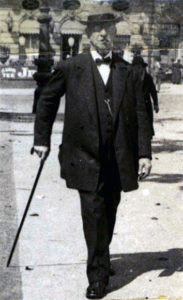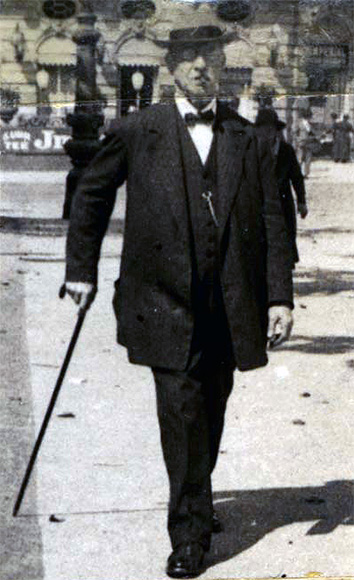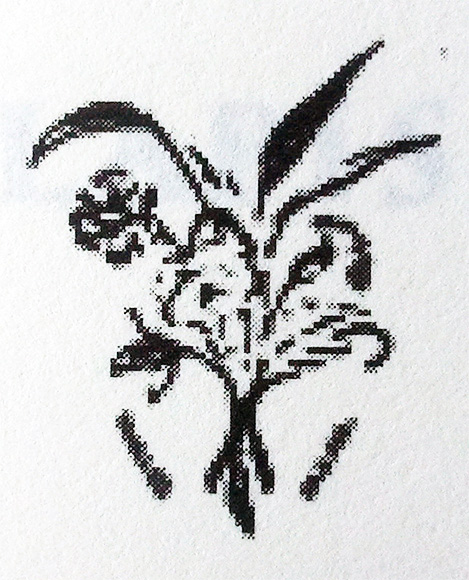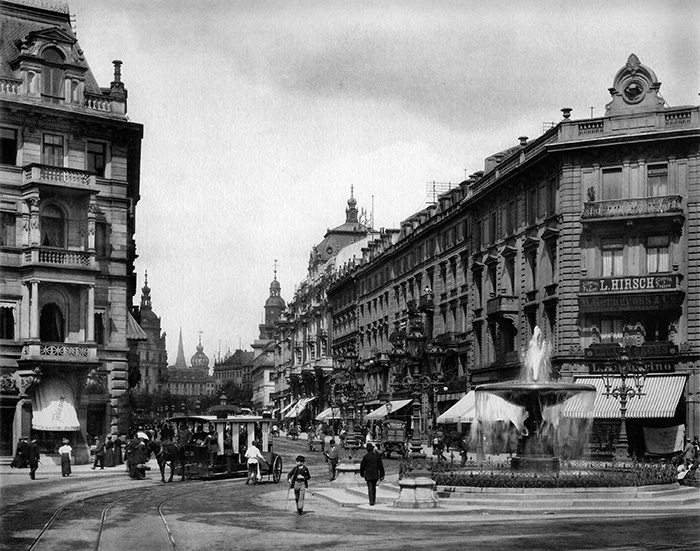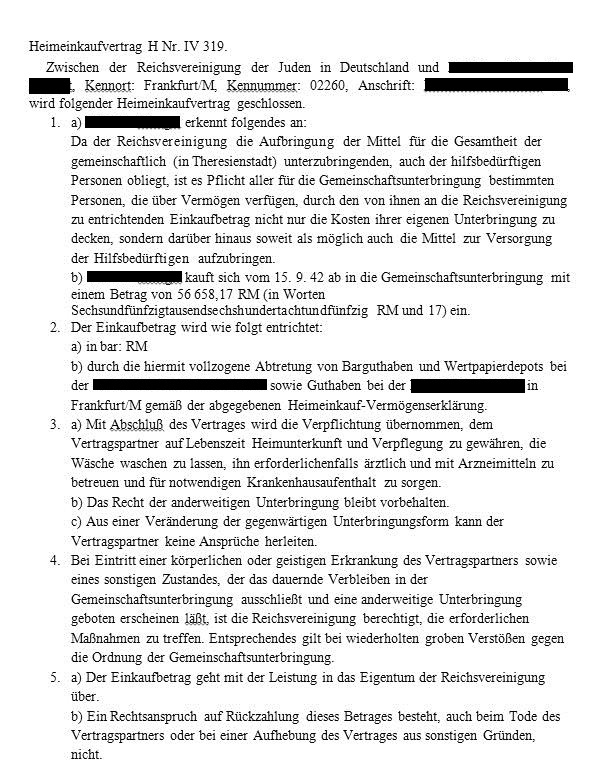Biographical data of Joseph and Hannchen May and their children Julius, Arthur and Rege
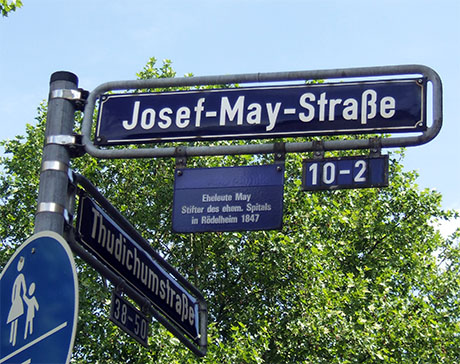
© Edgar Bönisch
In Frankfurt´s district Rödelheim there is a street called “Josef-May-Strasse”. An additional text explains: “The May couple – founders of the former Rödelheim hospital 1847”. This hospital is still remembered by some Rödelheim citizens. Until 1893 it was located opposite May Street, where now the Social and Rehabilitation Center resides. After first researches in the institute for city history I needed to correct the additional sign. Mr and Mrs May were not the founders, but in their honor the hospital was founded by their children in 1874, not in 1847. In the first part of this article I introduce the May family, the spouses Joseph Hirsch and Hannchen May and three of their five children Julius, Arthur and Recha, who became active as foundress and founders. In the second part I go into the different foundations of the family members.
The May Family
Initially, the May family lived in Rödelheim, which had been part of the Grand Duchy of Darmstadt since 1806. In 1866 Rödelheim became Prussian, and was incorporated into the city Frankfurt am Main in 1910. Around 1814 the proportion of Rödelheim´s Jewish population was almost 30% (342 people). There are 376 Jewish people documented in Rödelheim for 1866, who represented 13.1% of the population.
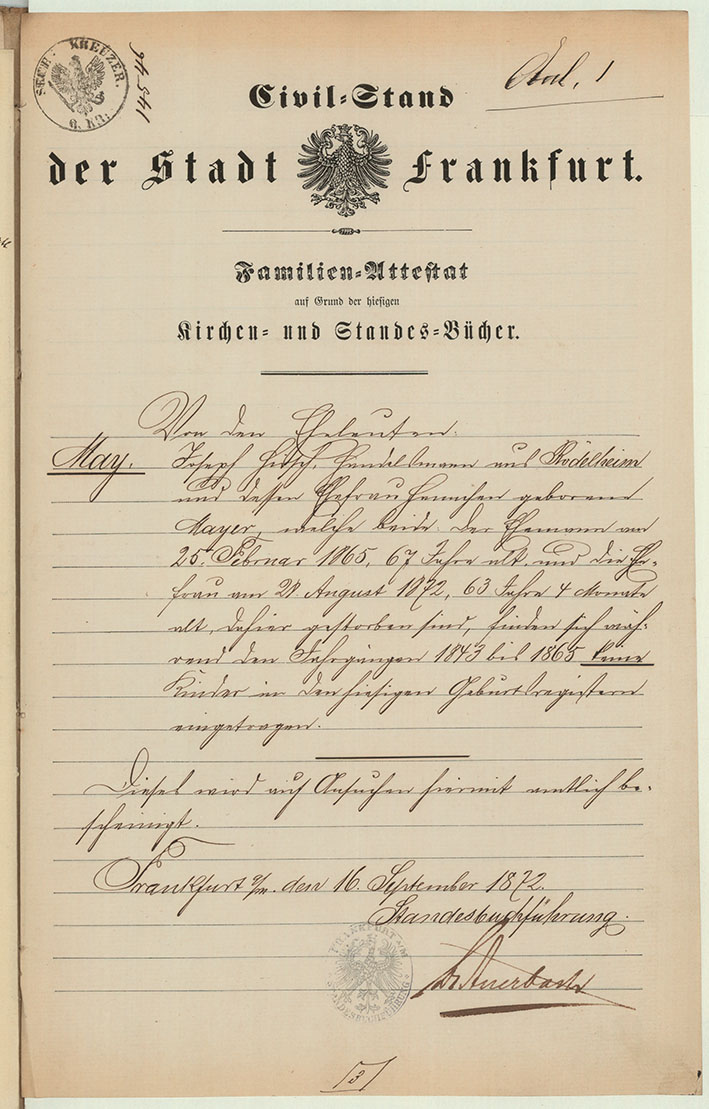
© Institute for the History of Frankfurt am Main
Joseph Hirsch May was born around 1797; his wife Hannchen (Johannette) May, née Mayer, in May 1809 (cp. ISG Ffm: estate record 420, Documents of civil status). In 1825 Joseph Hirsch May, a “Jew under special protection”, applied to the Grand Ducal Hessian Government of the Province of Upper Hesse for the citizenship with the intention to be allowed to trade independently. Therefore he had to prove assets of 4,000 Guilders (Inferendum), in which he could include his wife´s funds. The law stated: “The higher authorities have decided that 4,000 Guilders, a Jew under special protection, who intends to become a citizen and to live on trade, has to prove may also include the funds of his bride” (HStAD Best. E3 A No. 26/31).
On January 22, 1826 the tradesman Joseph Hirsch May and Hannchen Mayer entered into marriage. Their first child, son Israel (later Julius), was born in the same year. In 1828 he was followed by Aaron (later Arthur). In 1831 their first daughter Röschen (Rosa) was born, followed by Rege (Rega / Recha) in 1835 and Jenny in 1843.
In 1856 the family moved from Rödelheim to Frankfurt (cp. ISG Ffm: estate record 420). Joseph Hirsch May died on February 25, 1865; his wife Hannchen on August 28, 1872 (cp. ISG Ffm: Foundation Department 310, sheet 47).

© Hessisches Staatsarchiv Darmstadt (Best. E 3 A Nr. 26/31)
According to his testament, Julius (Israel) May (cp. ISG Ffm: magistrate records V 465; ISG Ffm: Foundation Department 310, sheet 47) was born in Rödelheim on November 11, 1826. Particularly worth mentioning is that Julius May received the citizenship of California in the United States on November 2, 1859. Though another source mentions his emigration to America in 1866 (cp. HStAD Best. R 21 B No. proof 1866), his stay in America in 1859 seems to be likely due to the fact that he got married in Belgium in 1864. In 1865 Israel May had his name changed into Julius May (cp. HStAD Best. G 15 Friedberg No. I 61).
The time Julius May spent in America cannot be reconstructed, however, on the basis of the following text conjectures can be made.
After only a few Jewish people from Central Europe emigrated to America in the 18th century, the number of Jewish residents in the United States increased from about 15,000 to about 250,000 between 1840 and 1880 (cp. Brunner 2009: 55). “A large part came from villages and smaller cities in Swabia, Bavaria, Hesse, Baden and Westphalia” (Brunner 2009: 55). In Germany Jews suffered from discrimination; the laws regulating the number of Jews who were allowed to be legal residents of any location (Matrikelgesetz) were directed against the free choice of occupation and residence. Economic, as well as political and social, discrimination stimulated the desire to emigrate. Many of the emigrating Jews were young, unmarried and poor. Often it was the first born son of a family who was sent traveling. Also young Jewish families often emigrated, since the number of Jewish marriages was limited by the authorities. In addition to settlements in New York and Chicago many Jews also settled in the “Southern states and the pacific West” (cp. Brunner 2009: 56). Julius May came from a rich family, but was the first born son. Whether it was the gold fever in the middle of the 19th century which called him to California, to San Francisco around 1849, or the first Jewish communities that were formed in the West during this time, we do not know.
On November 2, 1864 Julius May married Fanny Angela Oppenheim (1841-1918) in Belgium, who was the daughter of Joseph Oppenheim. Their children were Rose Eugenie, Joseph Henry, Adolphe Maurice and Paul Hermann (cp. magistrate records V 465).
Not much is known about the life of Julius May and his family in Belgium. The following is described in literature regarding the situation he and other Jewish people from Frankfurt faced in Belgium in the 19th century: “Migrants from Frankfurt am Main belonged to the first permanent residents in Belgium in the late 18th century. The family pioneer Adolphe Oppenheim settled in Brussels in 1807/1808. His brother Joseph [Julius May´s father in law], other siblings and close relatives followed from 1814” (Kasper-Holtkotte 2003: 165). One of the main reasons for migrating from Frankfurt to Belgium was Jewish people being rejected by Frankfurt´s population, and a change of the legal situation seemed to be hopelessness. A complaint of the Israelite Singer states that “the hate against Jewish people here in Frankfurt (…) is extremely fierce” and includes all classes of society (Singer). An anti-Semitic climax was reached with the decree of the “New Saturation”: It reinforced the lawlessness of Jewish people including the deprivation of civil rights (cp. Kasper-Holtkotte 2003: 219).
Julius May died in Ixelles near Brussels in 1890. He appointed his “nephew and future son-in-law” Dr. Leo Errera, his wife Fanny Angela and her brother Paul Moise Oppenheim as managers of his American assets (magistrate records V 465).
The second eldest son of Joseph and Hannchen May and brother of Julius was Arthur (Aaron) May (September 8, 1828 – May 30, 1885). He married Pauline Fuld (July 26, 1833 – April 14, 1870) on February 14, 1855 (cp. ISG Ffm: Foundation Department 310, sheet 47). Their children were Julie Mathilde, Victor, Rosa and Joseph Arthur.
Following the example of his parents, Arthur May and his fiancé succeeded in keeping their civil and trade rights in Frankfurt by proving assets to the amount of 20,000 Guilders (cp. ISG Ffm: Senate Supplication 631/14). On November 6, 1854 a receipt was issued for Arthur May that he had paid 918 Guilders and 11 kreutzer in total for “civil or suit money” plus statutory charges.
The move from Rödelheim to Frankfurt is proved by the address book of the City of Frankfurt from 1855, where the merchant Aaron [sic] May is listed under his private and business address at 1 Friedberger Anlage (cp. state and address book of the Free City of Frankfurt 1855).Even before his brother, Aaron May applied for his name being changed into Arthur May (cp. ISG Ffm: Senate Supplication 631/14).

© Institute for the History of Frankfurt am Main
In accordance with Frankfurt´s address book Arthur´s father, Joseph Hirsch May, was registered as the attorney of the business at 1 Friedberger Anlage in 1865. Arthur´s sister Rege Seligstein, who had participated in the financing of the Joseph and Hannchen May Foundation, probably lived under the same address on the second floor. Rege´s husband, Samuel, was listed as the co-owner of a branch at 26 Vilbeler Strasse, which seemed to have been additionally bought.
By looking at the complaint Aaron May submitted to the financial administration in 1860 it is possible to get an idea of the products the May family traded with in its commission and freight forwarding business. The complaint was about oats Arthur May had resold on account of the War Ministry. He requested the reimbursement of Accife (consumption tax) on oats by the financial administration, but was unsuccessful (cp. ISG Ffm: Senate Supplication 631/14).
Arthur and Pauline May both died in Frankfurt: Arthur died on May 30, 1885 and Pauline on April 14, 1870 (cp. ISG Ffm: Foundation Department 310, sheet 47). Currently, not much is known about the life of the daughters of Joseph Hirsch May and Hannchen May, Röschen, Rege and Jenny.
Let us now look at the foundations that were set up by members of the May family.
The Josef and Hannchen May Foundation for Sick and Needy People

© Edgar Bönisch
The above-mentioned street sign refers to this foundation. Rödelheim´s first almshouse and infirmary was founded by the sons of Josef and Hannchen May, Julius and Arthur in honor of their parents. They donated “the then so-called Little Hospital without any proportions of public funds […] ” to the City of Rödelheim (Schembs 2007: 18). Their sister Recha and her husband Samuel contributed to the maintenance of the house. It was officially opened in 1874.
A nameplate, which probably adorned the old hospital, still exists in the garden of the Social and Rehabilitation Center West which was later built there. Reference is made to two detailed articles about the foundation and the building and its residents.
Foundations of Julius May (1826-1890)
Julius May, the eldest son of Josef and Hannchen May, determined in his will dated June 4, 1885 that his heirs shall invest “about 35,000 Marks as Julius May Foundation” (ISG Ffm: magistrate records V 465, attachment X). The resulting dependent foundation under the administration of the Philanthropin, one of the schools of the Jewish community, aimed at improving and enhancing the lessons, the locations and the equipment of the Philanthropin and granting scholarships to talented and needy Jewish children (cp. Schiebler 1988: 28). When the funds of the foundation were not paid to the Philanthropin in 1940, the executive board contacted the city council. Investigations, in which also the Gestapo was involved, were carried out. It was established that the foundation assets were RM 8,744.90 and deposited with the J. Dreyfuss bank. When the Dreyfuss-bank had been “aryanized” and liquidated, the money had flowed to various banks, which was why the whereabouts of the single amount were no longer traceable. This was given as a reason for the missing payments (cp. ISG Ffm: magistrate record V 465, Foundation Department 312).
In accordance with the testament two further foundations were set up (cp. Schiebler 1988: 28).
1) Christian or non-denominational poor people from Rödelheim shall be supported with 12,000 Marks. Due to the inflation the foundation amount managed by the finance administration of the City of Frankfurt dwindled down to RM 1,518 until 1929 and was incorporated into the poor relief fonds of the City of Frankfurt.
2) Julius May donated 12,000 Marks to the Joseph and Hannchen May Foundation for the distribution to poor Jewish people.
The Foundation Department of the legal office tried to clarify the respective status of the different May Foundations in a letter addressed to the Main Office of Administration of the City of Frankfurt from March 1941.
Assuming that “the different May Foundations […] had not always been called the same, which resulted in some confusion,” (ISG Ffm: Foundation Department 312) it was concluded that the Joseph and Hannchen May Foundation was a donation in legal terms. The legal office did not consider the amount of 12,000 Marks given to the Joseph and Hannchen May Foundation by Julius May for the distribution to poor Jewish people (see point 2 above) as a foundation, but as a donation to the Municipality of Rödelheim from 1891. Regardless of what was legally correct, it was surely easier to “aryanize” the endowments.
Foundations of Arthur May (1828-1885)
In accordance with his testament Arthur May put capital to the amount of 60,000 Marks into the “Arthur May Foundation for the Support of Poor People” in 1885 (cp. ISG Ffm: Foundation Department 310, magistrate records V 456/1). Regardless of religious affiliation amounts shall be paid to individuals who “did not receive any benefits from public funds” (Schiebler 1988: 114). The often informal requests and corresponding receipts can be found in the institute for city history in Frankfurt am Main. Initially, the support amounted to five or ten Marks, later also 20, 30 or 100 Marks (cp. ISG Ffm: magistrate records V 456/2).

© Institute for the History of Frankfurt am Main
The executive board of the Arthur May Foundation finally consisted of the factory owner Julius Bloch, the medical officer Dr. Albert Ettlinger, the mayor Dr. Eduard Gräf and the city councilors Heil and Weidner (cp. ISG Ffm: Foundation Department 310, sheet 3). The last mentioned gentlemen probably were the city councilors Gerhard Heil and Wilhelm Weidner. The Arthur May Foundation was dissolved by an order of the district president in Wiesbaden on January 3, 1939. The foundation assets of RM 22,000 were to be transferred to the General Welfare Foundation (cp. ISG Ffm: Foundation Department 310, sheet 87). The explanatory memorandum states: “For the administration of the foundation an executive board of five people was appointed in the deed stipulated by the magistrate on January 8, 1886, of which two had to be of Jewish faith. As investigations with the registration office revealed, the two Jewish members last appointed to the board last, are staying abroad. The medical officer Dr. Albert Ettlinger emigrated to The Netherlands on September 22, 1938. The factory director Julius Bloch is still registered here, but is staying abroad with unknown residence. The remaining three [sic] members of the foundation executive board have made the enclosed decision. In accordance with the provisions for the administration of the foundation, which have been enacted by the magistrate, a quorum is constituted by the presence of three members so that a valid [sic] decision of the executive board exists” (ibid. sheet 85).
In accordance with his testament Arthur May donated a further 10,000 Marks to the Joseph and Hannchen May Foundation for the distribution of meat and sacrificial bread to poor Rödelheim Jewish people. This amount was also called a donation for the Easter feeding of poor Jewish people in May 1886 (cp. ISG Ffm: Foundation Department 312).With its foundations the May family lines up with many other foundresses and founders in Frankfurt am Main, completely committed to the principle of justice and charity (tzedakah).
Edgar Bönisch, 2014

